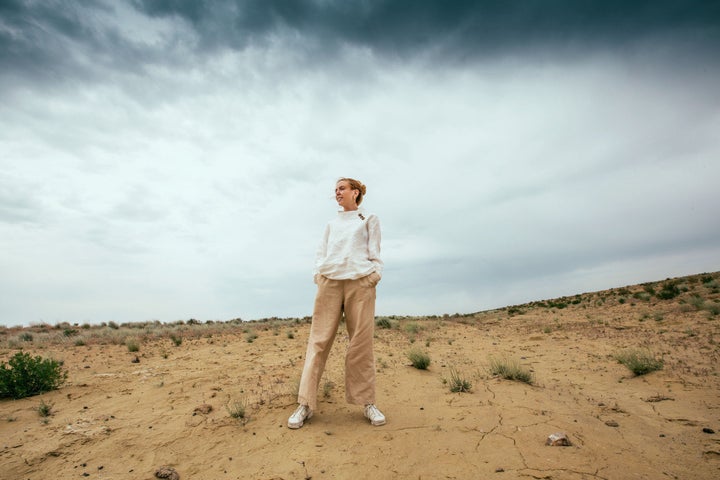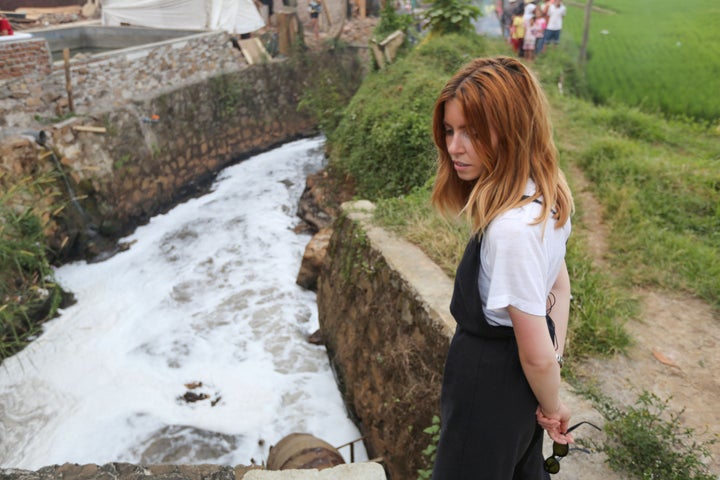As Stacey Dooley walks across a dried up desert that was formerly an inland sea in Kazakhstan, you see a look of complete despair cross her face. The disappearance of the Aral sea is one of the biggest environmental disasters linked to the garment industry. What was once home to thousands of fish and wildlife is now a vast desert sparsely populated by the odd shrub or camel.
The reason for its disappearance is simple: rivers that once ran into the sea were diverted, primarily to keep cotton fields supplied with water. And it’s impacted everything from the weather (harsher summers and winters) to the health of the local community.
An area of water the size of Ireland has disappeared in the space of 40 years. But it’s not something many people outside Kazakhstan will know about. “I don’t think you understand the enormity of the situation, until you’re here,” said Dooley. “I feel like we understand what plastic does to the Earth, for example, we’re fed that every day – and rightly so.
“But did I know that cotton was capable of this?” she added, waving her hand at the barren landscape surrounding her. “Of course I didn’t. I had no idea.”
‘Stacey Dooley Investigates: Fashion’s Dirty Secrets’ is truly numbing to watch – but here’s what we learned from the show.

1. The fashion industry is one of the planet’s biggest polluters.
“I think there is credible evidence that says that garment and apparel production is one of the top five polluters globally,” Lucy Siegle, broadcaster and journalist investigating fashion’s environmental footprint, told Dooley.
“It’s not sustainable, it’s on borrowed time, because what we’re doing is we are producing over 100 billion new garments from new fibres every single year – and the planet cannot sustain that.”
When Dooley asked people in the street where they would rank the fashion industry compared to other industries like coal and oil, fracking and meat, fashion was often ranked last. Actually, it’s considered up there with coal and oil in terms of environmental impact. In the UK, 300,000 tonnes of clothes are dumped in landfill each year. Furthermore, microfibres washed out of clothes have become a significant cause of plastic pollution in rivers and oceans.
2. Cotton is very bad news.
It might surprise you because of the way it’s marketed as clean, fresh and natural, but cotton is actually one of the most unsustainable crops on the planet because of its reliance on water and chemicals.
One prime example of this is the disappearance of the Aral sea. Granted, some of the sea has been saved from the cotton industry, but the lasting impact of the sea’s decline is beyond terrible – with loss of jobs (thanks to the decline of the fishing industry), poorer health and extreme weather (including sandstorms that can be seen from space), to name a few.
During an experiment which saw Dooley tally up the amount of water that would be needed to produce cotton clothes, shoppers back in the UK were shocked to discover that one carrier bag of clothing would have been produced using the equivalent of 80 years of drinking water for one person. The revelation leaves one shopper on the verge of tears.

3. Our rivers are being polluted with devastating consequences.
In Indonesia, Dooley visited one of the “world’s most polluted rivers” – the Citarum – which is now so full of chemicals that dead birds and rats float past her boat. There are hundreds of local garment factories pumping chemicals into the river, which children swim in and whose water is still used to irrigate crops.
Dooley and her team collected a sample of black liquid being pumped into the river, which was boiling hot. The river bubbled away at the side of the boat and Dooley looked genuinely frightened. When she asked why it was foaming, one of the environmental activists said it was because oxygen levels in the river were depleted due to chemicals, which killed off all the wildlife. Heartbreaking.
When a local scientist tested the sample, he revealed that the water contained mercury, cadmium, lead and arsenic. Long-term exposure to these can cause all kinds of health issues, including neurological problems – and millions of people are exposed to this water.
4. A lot of big brands aren’t taking responsibility.
During filming for the documentary, Dooley attended a huge sustainability summit in Copenhagen which saw her in the same room as leaders from the likes of fast fashion giants ASOS and Primark. But when she approached them for comment on what they’re doing to limit the problem, nobody would talk to her.
She did manage to speak to the head of innovation at Levi’s who spoke frankly about how the company is coming up with solutions to reduce water waste. “We’re working on a solution that takes old garments, chemically deconstructs them, and turns them into a new fibre that feels, looks and behaves like cotton with zero water impact,” said Paul Dillinger. “In the meantime we’re doing everything we can to use less water in our finishing, and when we figure out a way to use less water, we’ll share it with everyone. We make all of our proprietary formulations open-source because if you figure out how to save water and you don’t tell people about it, you’re kind of a jerk.”
The reality is that big brands won’t change their production processes unless someone comes up with a solution or new laws enforce them to do so.
5. We can’t carry on this way.
The fashion industry is using up water with devastating consequences. Suppliers are dumping toxic chemicals into natural resources with devastating consequences. If there’s one thing we’ve learned, it’s that something has to change.
The chairman of the Textile Manufacturers Association in Indonesia told Dooley he cannot enforce regulation on factories in the area, the only people that can do so are the police. Defeated by the situation and utterly desperate, he urged Western clothing brands to investigate their suppliers more to see if they care about the environment or not.
“The problem is getting worse and worse,” he said. “The condition between developing countries and developed countries – they are not connected well on this issue. They need to connect very well, otherwise the planet is gone – because water is our life, water is our future.”
Among shoppers, a boycotting of brands to make them accept change needs to happen feels like the only solution. And in a world increasingly burdened by pollution and fast running out of resources, something needs to happen fast.
‘Stacey Dooley Investigates: Fashion’s Dirty Secrets’ is on BBC1 at 9pm on Monday October 8 and viewable here.